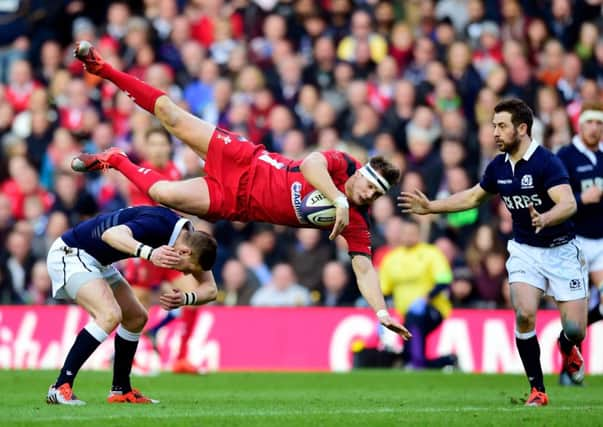Allan Massie: Eliminate dangerous challenges


The obvious conclusion is that it was an accidental collision, one of these things that happen in the course of a match; and this would have been the official judgment even a few years ago. Rugby is a physically violent and therefore dangerous game and players get hurt in collisions. In this instance, happily, nobody was badly hurt, though in a still shot when both players were on the ground, it was Russell who was holding his head, while Biggar was evidently unharmed.
Wales benefited from the incident, being awarded a penalty which Leigh Halfpenny kicked and then scoring a try while Russell was in the sin-bin. That surely should have been the end of the matter, but the citing commissioners decided otherwise, and the sentencing panel agreed with him. Scotland will appeal, but must know that appeals are rarely successful unless backed by new evidence. So we are likely to be without Russell for the Italian match.
Advertisement
Hide AdAdvertisement
Hide AdWhatever the rights and wrongs of the judgment, the authorities are now rightly aware of the dangers of the sport. These are most evident of course in the professional game, where players are bigger, heavier and stronger than they were even four or five years ago. But the practices of the professional game are copied by amateur clubs and by schools. So developments at pro level influence developments elsewhere.
Four current practices seem worrying to me. The first is high tackling. The tackle round the neck, often a stiff-armed tackle, has rightly been made illegal, and is punished more often that not. But the head-on chest-high tackle has become common, and is favoured by coaches because, when supported by a second tackler, it offers a means of preventing the ball-carrier from going to ground; consequently the tackling side may be rewarded with the put-in at a resultant scrum. But it is dangerous because it will often lead to a clash of heads.
There were two horrid examples of this in the Ireland-France match, both involving Jonny Sexton as the tackler and Matthieu Bastereaud, the ball-carrier. In both cases, Sexton was in an almost upright position as he tried to stop the huge French centre. It would have been no surprise if both players had been knocked out, so violent was the collision.
Second, the prevalence of this sort of tackle has led to the ball-carrier holding his arm across his chest, and in effect meeting the tackler with an elbow or forearm smash. Bastereaud and other powerful centres regularly carry the ball in this fashion.
It is extremely dangerous and should be stopped. However, it is, as I say, the consequence of this style of tackling.
There are two possible remedies. The first is to make any tackle above the waist illegal. We may come to this, but there are all sorts of difficulties, one obvious one being that, depending on the angle, above-the-waist tackles may not be dangerous at all. The second is to revise the law relating to the ball becoming unplayable after a tackle. There is no obvious reason why the tackling side should benefit from preventing the ball from being grounded. The third cause for alarm is the number of tackles made without use of the arms, tackles which are, in fact, only a shoulder charge, This is, of course, already illegal, but a practice far too often ignored, or lightly policed, by referees.
The fourth development is, to my mind, the most worrying of all. This is the practice of a player running on to a short pass, usually near a ruck or maul, and then charging head-down, body bent double, at an opponent. This happens again and again in every match, and I’m amazed it hasn’t resulted in more serious injuries, even in broken necks. It could be outlawed easily by a law forbidding a player carrying the ball to lead with his head.
By its nature, rugby, like other sports – not all of them contact ones – can never be entirely safe. Accidents will happen. Injuries, often serious ones, will occur. But it is the duty of the law-makers to do what they can to eliminate practices that make the game unnecessarily dangerous.
Advertisement
Hide AdAdvertisement
Hide AdThe four common and dangerous practices I’ve described could all be stopped by amendments to the laws of the game. Power and violence are inherent in rugby, but should be subject to strict control, more than there is now. I would add only that the game would be a better spectacle if high tackles were eliminated and coaches at all levels insisted their players should, whenever possible, tackle low and hard in the classical style.
FOLLOW US
SCOTSMAN TABLET AND MOBILE APPS